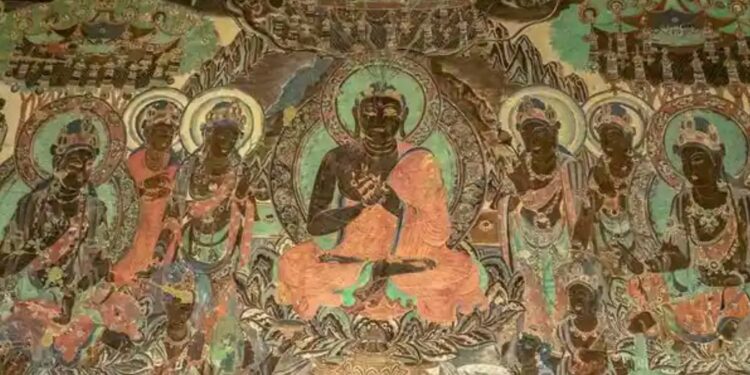As yet another face-off between India and China in Arunachal creates tremors in the political sphere, the diplomatic relations between both countries in the glorious past are once again in the news. The first records of contact between China and India were written during the 2nd century BCE, especially following the expedition of Zhang Qian to Central Asia (138–114 BCE). Buddhism was transmitted from India to China in the 1st century CE.
Chinese diplomat, essayist, literary scholar, philosopher, and politician Hu Shih once said, “India conquered and dominated China culturally for 20 centuries without ever having to send a single soldier across her border.” A similar statement was made by defence minister Rajnath Singh in 2017 on the occasion of Paryatan Parv, a nationwide tourism festival, which was promptly opposed by the Chinese communist state and its mouthpiece the Global Times.
Let us explore some of the facets & personalities pivotal in Indian-isation of China.
ANCIENT CHINESE EDUCATION SYSTEM
Ancient Chinese education served the needs of a simple agricultural society with the family as the basic social organization. Paper and the writing brush had not been invented, and the “bamboo books” then recorded to be in existence were of limited use at best. Oral instruction and teaching by example were the chief methods of education.
The moulding of character was a primary aim of education. Ethical teachings stressed the importance of human relations and the family as the foundation of society. Filial piety, especially emphasizing respect for the elderly, was considered to be the most important virtue. It was the responsibility of the government to provide instruction so that the talented would be able to enter government service and thus perpetuate the moral and ethical foundation of society.
BUDDHISM
The Han dynasty was a period of territorial expansion and growth in trade and cultural relations. Buddhism was introduced at this time. Early information about Buddhism was probably brought into China by traders, envoys, and monks. By the 1st century CE an emperor became personally interested and sent a mission to India to seek more knowledge and bring back Buddhist literature. Thereafter Indian Buddhists as well as Chinese scholars translated Buddhist scriptures and other writings into Chinese.
Indian Buddhists not only preached a new faith but also brought in new cultural influences. Indian mathematics and astronomical ideas enriched Chinese knowledge in these fields. Chinese medicine also benefited. Architecture and art forms reflected Buddhist and Indian influence. Hindu chants became a part of Chinese music.
For a couple of centuries after its introduction, however, Buddhism showed no signs of popular appeal. Han scholarship was engrossed in the study of ancient classics and was dominated by Confucian scholars who had scant interest in Buddhist teachings that were unconcerned with the practical issues of moral and political life. Moreover, the Buddhist view of evil and the Buddhist espousal of celibacy and escape from earthly existence were alien to China’s traditions. Daoist scholars, finding in Buddhism much that seemed not too remote from their own spiritual message, were more inclined to study the new philosophy. Some of them aided in the translation of Buddhist texts, but they were not in the centre of the Han stage.
The fall of the Han dynasty was followed by a few hundred years of division, strife, and foreign invasions. China was not united again until the end of the 6th century. It was during this period that Buddhism gained a foothold in China. The literary efforts of Chinese monks produced Chinese Buddhist literature, and this marked the beginning of a process that transformed an alien importation into a Chinese religion and system of thought.
THE WHITE HORSE TEMPLE
The most famous account regarding the introduction of Buddhism to China comes from the Han Dynasty Emperor Ming who saw in a dream a flying God whose body had the brilliance of a sun (Maspero, 1981:402). When he asked what God is this, he was told that there was a man in India who had achieved the Tao or ‘the way’, as understood in Taosim. The Emperor sent envoys to India to make inquiries about this God and sutras were returned on the backs of white horses to the then capital of Luoyang. In short order, the first dedicated Buddhist site in China, known as the White Horse Temple, was constructed. Two Indian monks named Dharmaratna and Kasyapa Matanga returned with the entourage.
BODHIDHARMA
Bodhidharma was a semi-legendary Buddhist monk who lived during the 5th or 6th century CE. He is traditionally credited as the transmitter of Chan Buddhism to China, and regarded as its first Chinese patriarch. According to a 17th-century apocryphal story found in a manual called Yijin Jing, he began the physical training of the monks of Shaolin Monastery which led to the creation of Shaolin kungfu. He is known as Dámó in China and as Daruma in Japan. His name means “dharma of awakening (bodhi)” in Sanskrit.
Bodhidharma was born a prince in the Pallava Kingdom in South India. He was the third son of the king Sugandha of Kanchipuram in late 5th century, but at an early age, he left his kingdom and princehood and became a monk. At the age of twenty-two he was fully enlightened, and that was when he was sent as a messenger to China. Bodhidharma was the second Indian Buddhist monk to travel to Southern China.
According to traditions, he was the founder of Zen, or Ch’an Buddhism.Gautama the Buddha taught Dhyan or meditation. Hundreds of years later, Bodhidharma transported Dhyan to China where it became Chan. This Chan went further down to Indonesia, Japan, and other far east Asian countries, where it became Zen.
Bodhidharma was both a pilgrim and a missionary, sent to China by the famous monk Prajnatara to spread Buddhism, as predicted by the Buddha himself according to Hsuan Hua (1999:7). Places in China associated with Bodhidharma have become major pilgrimage sites, including the cave on Bear’s Ear Mountain where he meditated for nine years.
While Bodhidharma is virtually unknown in India, apart from the controversial 2011 film, 7am Arivu, his legacy in China, Japan and Vietnam is very considerable. As mentioned, he is honoured for bringing ‘Chan’ (pronounced ‘Chen’) Buddhism to China, and ‘Zen’ thereafter – in succession to Japan. It is also claimed on the website of the US
Shaolin Temple and numerous other sources that Bodhidharma, the author of such memorable meditations as the ‘Bloodstream sermon’, also brought Kung Fu to China’s Shaolin monks , but again there are no substantiating records. The Shaolin headquarters that sits on Mt Song, one of China’s holy mountains – which was built to honour an earlier Indian monk – is a major pilgrimage destination for devotees of Bodhidharma, and for Zen Buddhists as a whole.
XUANZONG
Xuanzang was born in central China in 602 CE and he is the most well-known of the monks who headed west to India, to the centre of the Buddhist world, in search of deeper understandings and better translations of the sutras (or ‘seeds’) – the ancient Buddhist texts or scriptures. He was a self-described pilgrim and was motivated by the fact that his people were in need of relief from their suffering. In his journey he would visit all the great Buddha pilgrimage sites in Indu (Yin-tu )or India, including what is now Afghanistan, Pakistan,
Nepal and Bhutan. He did not go to Ceylon (Sri Lanka) like some of his predecessors including the noted monk-traveller Faxian, but from the Indian coastline he claimed in his report Xiyou-Ji (Great Tang Records on the Western Regions) to have seen across the waters the glittering rays of the precious gem that sits atop the Temple of Buddha’s Tooth. Its appearance was described by him as being like that of a shining star in the midst of space.After a journey of 19 years, Xuanzang returned as a hero to China’s royal court in Xian bearing sutras, sacred statues of the Buddha, and over 100 Buddha relics. Several years later, the Great Wild Goose pagoda was commissioned by the Tang Emperor to house these sacred objects and it became a great centre of Buddhist learning, with pilgrims coming from all over East Asia to study.
KUMARAJIVA
Another Indian monk named Kumarajiva achieved acclaim throughout China as one of the four great translators of the Buddhist sutras. His father, also a monk, had come from Kashmir as a missionary with the goal of leading every human of China to Buddhism. Kumarajiva lived about 200 years before Bodhidharma.
OTHER SACRED JOURNEYS
- Hiuen-Tsang, a Chinese traveller, visited India during the reign of Harsha. His object was to secure authentic Buddhist scriptures and visit places of Buddhist interest. Hiuen Tsang stayed for almost 15 years in India.
- Faxian, also referred to as Fa-Hien, Fa-hsien and Sehi, also was a Chinese Buddhist monk and translator who travelled by foot from China to India to acquire Buddhist texts. Fa-Hien/ Faxian’s visit to India occurred during the reign of Chandragupta II (Vikramaditya).
- Yijing, formerly Romanized as I-Ching or I-Tsing, born Zhang Wenming, was a Tang-era Chinese Buddhist monk famed as a traveller and translator. His account of his travels is an important source for the history of the Medieval kingdoms along the sea route between China and India, especially Srivijaya in Indonesia. I-Tsing left for India from Canton by sea in 671, arriving in India in 673. After visiting the sacred Buddhist sites in Magadha, he resided at the great Nalanda monastery for ten years (676-685), devoting himself to the study of the Vinya.
Reference:
- Chinese Philosophy & Intellectual History ( Volume 2) – Hu Shih
- Ferguson, A (2012) Tracking Bodhidharma: A Journey to the Heart of Chinese Culture.
- Kieschnick J & Shahar M (2014) India in the Chinese
- Imagination. Myth, Religion, and Thought. Philadelphia: University of Philadelphia Press.
- Grousset, R (1932) In the Footsteps of the Buddha.
Source:
HU SHIH: A GLIMPSE INTO INDIC DOMINATION OF CHINA by Sushant S Raghuvanshi
Originally published by Bharat Voice : https://bharatvoice.in/history/hu-shih-a-glimpse-into-indic-domination-of-china.html



















Discussion about this post